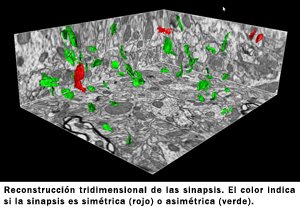New free software for neuroscience research
Researchers from 3 centres of Campus Montegancedo and from CSIC develop ESPINA, a software tool of freely available to study in depth the structure of brain.
As a result of a research within Caja Blue Brain project, researchers of Universidad Politécnica de Madrid (CeSViMa, Facultad de Informática, CTB) and of the CSIC (Laboratorio Cajal de Circuitos Corticales) have developed ESPINA, an application of freely available that will extract new information of structure of brain. In particular, they will extract information from images in three dimensions provided by an electron microscope. Experts will be able to analyse quantitative research of different structures presented in digital images of neural tissue. For example, synapses, mitochondria, vesicles, axons, dendrites.
 The investigation focuses on counting synapses on different layers of the cerebral cortex. The analysis of the results will establish new hypotheses about the organisation of neural connexions. The research is being applied to different species, including humans. Some results have been published in scientific journals and presented in international conferences.
The investigation focuses on counting synapses on different layers of the cerebral cortex. The analysis of the results will establish new hypotheses about the organisation of neural connexions. The research is being applied to different species, including humans. Some results have been published in scientific journals and presented in international conferences.
Exploring three-dimensional neural tissue
The main functions of the tool ESPINA are the three-dimensional exploration of neural tissue, the segmentation of structures for neuroscientist experts and the three-dimensional reconstruction of brain structures that are segmented or extracted from new parameters.
ESPINA has developed a language within the Python programming and is designed to use of freely available tools, such as QT for the development of a graphical interface, VTK to preview data in three-dimensional, and ITK for images processing. ESPINA is a multiplatform tool that it is being used on computers with Linux or Windows systems.
There is no other similar application with these characteristics at the moment. Thank to ESPINA, experts will be able to accelerate the analysis of available data with new technologies of data capture available today.

